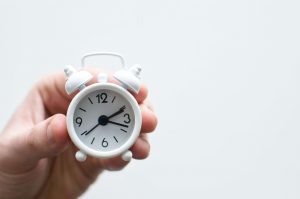Whether you’re looking for in-kind donations for promotional campaigns or financial sponsorship for an event, corporate sponsorships are a great way to make your budget go further while increasing reach and awareness for your cause. The right partnership can even help boost your nonprofit’s credibility in your community!
Once you’ve found the right partner, you’ll want to create a sponsorship proposal to send to your potential sponsor. Need help putting together a professional sponsorship packet that will help you secure those coveted sponsorships? Check out the sponsorship packet template below (and then download a copy to keep on hand).
What information should a sponsorship packet include?
Ready to create a sponsorship packet that helps your nonprofit stand out? Read on to get an understanding of the 8 key things you should include in your corporate sponsorship proposal.
Nonprofit Mission
There are over 1.5 million nonprofits registered in the U.S. alone. Instead of hoping your potential sponsor is familiar with your work, be sure to include a brief description of your nonprofit and your mission!
You’ll also want to include a few key stats to show why your nonprofit is an expert at serving your clients. Potential metrics to share include how long you’ve served your community, the number of clients served each year, or other metrics that describe real impact in your community, like a substantial increase in unhoused citizens finding permanent housing through your nonprofit.
Think of this as your elevator pitch: you want to keep it short, but make sure your nonprofit stands out!
Fundraising event details
Don’t forget to include your event’s name, date, start time, and location. While you want to keep this section short and sweet, it’s also important to include other key details, such as if your event will include a silent auction.
Fundraising event goal
If you need to raise a certain amount through your event, make sure to include that information for your potential sponsors. However, don’t just give your sponsors the dollar amount, describe the impact that amount will have in your community.
Target demographic
As much as many business owners love to give back to their communities, they also need to make sure their sponsorship reaches their target demographic so their sponsorship is financially viable for them. For example, a used car dealership might not be a great sponsor for an event targeting your major donors, but it could be perfect for a family-friendly event in support of animal rescue.
Including a few details about your potential attendees—such as age range, interests and hobbies, or location—can help your potential sponsor determine if your event is a good fit for their audience. Demographic information can also include things like gender, level of education, family status, household income, occupation, religion, or affiliations.
Sponsorship levels
It’s important to include a quick breakdown of all the sponsorship levels your nonprofit is offering. The teaser for each package should include a breakdown of overall cost and general benefits, such as the number of event tickets included in the package, and if the sponsor will be eligible for promotional opportunities.
Sponsorship benefits
This is where you want to break down the specifics of what the sponsorship benefits are. For example, if you listed promotional opportunities for some of your sponsorship levels, you’ll want to break down exactly what that means.
Will top level sponsors have their logo added to print materials? Will they get a mention and backlink on your nonprofit’s website? Will their sponsorship be mentioned in press releases?
Getting specific with the details can help your potential sponsors decide which package is going to give them the greatest return on their investment. When talking about social media promotions, it’s a good idea to go into even more detail and share specific information on the number of mentions they’ll get, the numbers of followers you have on each channel, and the reach for event posts from last year (if this is a repeat event).
Response deadline
Always include a response deadline in any sponsorship request. While it’s great when everyone on your first-round sponsorship list says yes, the reality of the situation is that it’s rare that you’ll get 100% of your sponsors during your first round of outreach. You’ll want to give yourself enough time to reach out to another round of sponsors in plenty of time to create your promotional materials.
Contact Information
Last—but certainly not least—don’t forget to include contact information for the person in charge of the event. Ideally, you’ll include both a direct phone number and email address. If the person handling sponsorships is not the person in charge of the event, make sure your sponsorship coordinator is prepared to answer any questions potential sponsors might have. It’s also a good idea to include your website at the end of your signature, so your potential sponsor knows where to go if they want more information.
How to Create a Professional-Looking Sponsorship Packet
Whether you need a sponsorship letter for a sports team or for a formal event sponsorship proposal, creating a professional-looking sponsorship packet can seem intimidating if you don’t have a professional graphic designer on your team. While great graphic design can be an invaluable tool for communicating your nonprofit’s branding and more, there are plenty of free design tools that nonprofits can rely on to create eye-catching graphics. Here are a few of our favorites:
- Visme is a tool that first came on my radar due to its video content capabilities. However, Visme offers far more than video-creating tools, and is a great place to design anything from social media graphics to infographics highlighting your nonprofit’s success.
- Canva Probably the most well-known in the free design tool space, Canva is an intuitive platform that offers a robust free tier, as well as paid professional accounts. You can easily use their tools to create everything from social media graphics to polished presentations and yes, even sponsorship packets.
- Easil is a drag and drop design platform with a variety of professional templates to choose from. While Easil offers a great free platform, their paid plan can help your whole team stay organized when working on design projects.
- VistaCreate can help you create great graphics in minutes for free! The tools offer thousands of professional templates that you can edit to meet your specific needs.
- Pixlr is a web-based online editor that allows you to edit photos and create designs right in your browser. Pixlr works with almost any type of image format and offers AI-powered tools for easy edits.
Sponsorship Packet Design
While the graphic design tools listed above will do wonders to help your nonprofit create beautiful graphics—even if you’re a beginner—there are a few best practices you should keep in mind when designing your nonprofit’s sponsorship packet:
- Keep it simple. Your potential sponsors are busy. Make it easy for them to make a decision by keeping your design clean, organized, and to the point. Use a simple color scheme with no more than 2-3 bright colors and a couple of classic neutrals to keep your design focused.
- Make it visual. It’s also important to minimize text, just like you would if you were creating a presentation to present to your board. Avoiding long paragraphs (anything over 5 lines or 3 sentences) will make your sponsorship packet easier to read and digest.
- Keep branding consistent. Keeping your branding consistent helps your nonprofit look professional. It also helps build trust, since potential sponsors will be able to verify that they are working with a legitimate nonprofit with a quick Google search.
- Use white space. Don’t cram all your text and design elements together. Use white space so each element can breathe. This makes it easier for your potential sponsors to read.
- Focus on impact. Unlike a basic sponsorship letter, a sponsorship packet gives you a little more room to add some flair in the form of concrete impact statements. For example, a simple call out that says “One $1,000 sponsorship = 200 meals served” helps your sponsor visualize the impact their contribution can have on the community.
Final Thoughts
And there you have it! Don’t forget to download a copy of the sponsorship packet template to keep on hand for future events.

Need ideas for planning your next fundraising event? Check out the following resources:







